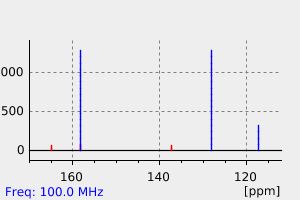N,N'-bis(2-pyrimidinyl)terephthalamide | 139522-10-4
中文名称
——
中文别名
——
英文名称
N,N'-bis(2-pyrimidinyl)terephthalamide
英文别名
N,N'-bis(pyrimidin-2'-yl)benzene-1,4-dicarboxamide;N,N'-bis(2-pyrimidinyl)-1,4-benzenedicarboxamide;N,N'-dipyrimidin-2-ylterephthalamide;1-N,4-N-di(pyrimidin-2-yl)benzene-1,4-dicarboxamide
CAS
139522-10-4
化学式
C16H12N6O2
mdl
MFCD01162856
分子量
320.31
InChiKey
TXRZUZQSSGAVKM-UHFFFAOYSA-N
BEILSTEIN
——
EINECS
——
-
物化性质
-
计算性质
-
ADMET
-
安全信息
-
SDS
-
制备方法与用途
-
上下游信息
-
文献信息
-
表征谱图
-
同类化合物
-
相关功能分类
-
相关结构分类
物化性质
-
熔点:271 °C
-
密度:1.455±0.06 g/cm3(Predicted)
计算性质
-
辛醇/水分配系数(LogP):0.8
-
重原子数:24
-
可旋转键数:4
-
环数:3.0
-
sp3杂化的碳原子比例:0.0
-
拓扑面积:110
-
氢给体数:2
-
氢受体数:6
反应信息
-
作为反应物:描述:水 、 N,N'-bis(2-pyrimidinyl)terephthalamide 、 mercury dibromide 以 N,N-二甲基甲酰胺 为溶剂, 以26%的产率得到([HgBr2(N,N'-bis(2-pyrimidinyl)-1,4-benzenedicarboxamide)]*H2O)n参考文献:名称:Structural diversity in Cu(II), Cd(II) and Hg(II) coordination complexes with the rigid N,N′-bis(2/3-aryl)-1,4-benzenedicarboxamide ligand摘要:The syntheses and structures of a series of metal complexes, namely Cu2Cl4(L-1)(DMSO)(2)center dot 2DMSO (L-1 = N,N'-bis(2-pyridinyl)-1,4-benzenedicarboxamide), 1; {[Cu(L-2)(1.5)(DMF)(2)][ClO4](2)center dot 3DMF}(infinity) (L-2 = N,N'-bis(3pyridinyl)-1.4-benzenedicarboxamide), 2; {[Cd(NO3)(2)(L-3)]center dot 2DMF}(infinity) (L-3 = N,N'-bis-(2-pyrimidinyl)-1,4-benzenedicarboxamide), 3; {[HgBr2(L-3)]center dot H2O}(infinity), 4, and {[Na(L-3)(2)][Hg2X5]center dot 2DMF}(infinity) (X = Br, 5; 1, 6) are reported. All the complexes have been characterized by elemental analysis. IR spectra and single crystal X-ray diffraction. Complex 1 is dinuclear and the molecules are interlinked through S center dot center dot center dot S interactions. In 2, the Cu(II) ions are linked through the L-2 ligands to form 1-D ladder-like chains with 60-membered metallocycles, whereas complexes 3 and 4 form 1-D zigzag chains. In complexes 5 and 6, the Na(I) ions are linked by the L-3 ligands to form 2-D layer structures in which the [Hg2X5](-) anions are in the cavities. The L-2 ligand acts only as a bridging ligand, while L-1 and L-3 show both chelating and bridging bonding modes. The L-1 ligand in 1 adopts a trans-anti conformation and the L-2 ligand in 2 adopts both the cis-syn and trans-anti conformations, whereas the L-3 ligands in 3-6 adopt the trans conformation. (C) 2010 Elsevier Ltd. All rights reserved.DOI:10.1016/j.poly.2010.08.025
-
作为产物:参考文献:名称:嘧啶二基刚性杆芳香聚酰胺的模型化合物的合成与X射线结构摘要:制备了各种基于嘧啶二基的刚性棒状聚酰胺聚[亚氨基-(嘧啶-2,5-二基)-亚氨基-四邻苯二甲酰基](PPYMT)的模型化合物,以便将它们的构象与该化合物的几种模型化合物进行比较。相关的全芳族聚合物聚对苯二甲酰对苯二酰胺(PPTA)。特别地,通过X射线衍射测定了N-(2-嘧啶基)苯甲酰胺(PYMB)及其复合形式的双[(N-嘧啶-2-基)苯甲酰胺]二氯化镍(II)镍(IIPYMB)的结构。这些晶体中的分子堆积为我们提供了PPYMT纤维可能“交联”的模型。三聚体模型化合物N,N'-双(2-嘧啶基)对苯二甲酰胺(PYTA)和N的结构,N′-双(苯甲酰基)-2,5-二氨基嘧啶(BDAP)产生有关PPYMT链构象的信息,并与PPTA的类似模型化合物进行比较。DOI:10.1002/hlca.19920750116
文献信息
-
Synthesis of<i>N</i>,<i>N</i>′‐<i>bis</i>(2‐Thiazolinyl)‐,<i>N</i>,<i>N</i>′‐<i>bis</i>(2‐Thiazolyl)‐, and<i>N</i>,<i>N</i>′‐<i>bis</i>(2‐Pyrimidinyl)‐Benzene Dicarboxamides作者:Sudershan R. Gondi、David Y. SonDOI:10.1081/scc-200028517日期:2004.1New heteroaromatic benzene dicarboxamides have been synthesized in moderate to good yields by the reactions of 2-aminothiazoline, 2-aminothiazole, and 2-aminopyrimidine with phthaloyl dichloride, isophthaloyl dichloride, and terephthaloyl dichloride in the presence of an organic base. The amides are sparingly soluble in common organic solvents but dissolve readily in dimethyl sulfoxide. Reactions of 2-aminothiazoline and 2-aminopyrimidine with phthaloyl dichloride yield a tricyclic compound and an imide, respectively, instead of the expected products.
表征谱图
-
氢谱1HNMR
-
质谱MS
-
碳谱13CNMR
-
红外IR
-
拉曼Raman
-
峰位数据
-
峰位匹配
-
表征信息
同类化合物
(βS)-β-氨基-4-(4-羟基苯氧基)-3,5-二碘苯甲丙醇
(S,S)-邻甲苯基-DIPAMP
(S)-(-)-7'-〔4(S)-(苄基)恶唑-2-基]-7-二(3,5-二-叔丁基苯基)膦基-2,2',3,3'-四氢-1,1-螺二氢茚
(S)-盐酸沙丁胺醇
(S)-3-(叔丁基)-4-(2,6-二甲氧基苯基)-2,3-二氢苯并[d][1,3]氧磷杂环戊二烯
(S)-2,2'-双[双(3,5-三氟甲基苯基)膦基]-4,4',6,6'-四甲氧基联苯
(S)-1-[3,5-双(三氟甲基)苯基]-3-[1-(二甲基氨基)-3-甲基丁烷-2-基]硫脲
(R)富马酸托特罗定
(R)-(-)-盐酸尼古地平
(R)-(-)-4,12-双(二苯基膦基)[2.2]对环芳烷(1,5环辛二烯)铑(I)四氟硼酸盐
(R)-(+)-7-双(3,5-二叔丁基苯基)膦基7''-[((6-甲基吡啶-2-基甲基)氨基]-2,2'',3,3''-四氢-1,1''-螺双茚满
(R)-(+)-7-双(3,5-二叔丁基苯基)膦基7''-[(4-叔丁基吡啶-2-基甲基)氨基]-2,2'',3,3''-四氢-1,1''-螺双茚满
(R)-(+)-7-双(3,5-二叔丁基苯基)膦基7''-[(3-甲基吡啶-2-基甲基)氨基]-2,2'',3,3''-四氢-1,1''-螺双茚满
(R)-(+)-4,7-双(3,5-二-叔丁基苯基)膦基-7“-[(吡啶-2-基甲基)氨基]-2,2”,3,3'-四氢1,1'-螺二茚满
(R)-3-(叔丁基)-4-(2,6-二苯氧基苯基)-2,3-二氢苯并[d][1,3]氧杂磷杂环戊烯
(R)-2-[((二苯基膦基)甲基]吡咯烷
(R)-1-[3,5-双(三氟甲基)苯基]-3-[1-(二甲基氨基)-3-甲基丁烷-2-基]硫脲
(N-(4-甲氧基苯基)-N-甲基-3-(1-哌啶基)丙-2-烯酰胺)
(5-溴-2-羟基苯基)-4-氯苯甲酮
(5-溴-2-氯苯基)(4-羟基苯基)甲酮
(5-氧代-3-苯基-2,5-二氢-1,2,3,4-oxatriazol-3-鎓)
(4S,5R)-4-甲基-5-苯基-1,2,3-氧代噻唑烷-2,2-二氧化物-3-羧酸叔丁酯
(4S,4''S)-2,2''-亚环戊基双[4,5-二氢-4-(苯甲基)恶唑]
(4-溴苯基)-[2-氟-4-[6-[甲基(丙-2-烯基)氨基]己氧基]苯基]甲酮
(4-丁氧基苯甲基)三苯基溴化磷
(3aR,8aR)-(-)-4,4,8,8-四(3,5-二甲基苯基)四氢-2,2-二甲基-6-苯基-1,3-二氧戊环[4,5-e]二恶唑磷
(3aR,6aS)-5-氧代六氢环戊基[c]吡咯-2(1H)-羧酸酯
(2Z)-3-[[(4-氯苯基)氨基]-2-氰基丙烯酸乙酯
(2S,3S,5S)-5-(叔丁氧基甲酰氨基)-2-(N-5-噻唑基-甲氧羰基)氨基-1,6-二苯基-3-羟基己烷
(2S,2''S,3S,3''S)-3,3''-二叔丁基-4,4''-双(2,6-二甲氧基苯基)-2,2'',3,3''-四氢-2,2''-联苯并[d][1,3]氧杂磷杂戊环
(2S)-(-)-2-{[[[[3,5-双(氟代甲基)苯基]氨基]硫代甲基]氨基}-N-(二苯基甲基)-N,3,3-三甲基丁酰胺
(2S)-2-[[[[[((1S,2S)-2-氨基环己基]氨基]硫代甲基]氨基]-N-(二苯甲基)-N,3,3-三甲基丁酰胺
(2S)-2-[[[[[[((1R,2R)-2-氨基环己基]氨基]硫代甲基]氨基]-N-(二苯甲基)-N,3,3-三甲基丁酰胺
(2-硝基苯基)磷酸三酰胺
(2,6-二氯苯基)乙酰氯
(2,3-二甲氧基-5-甲基苯基)硼酸
(1S,2S,3S,5S)-5-叠氮基-3-(苯基甲氧基)-2-[(苯基甲氧基)甲基]环戊醇
(1S,2S,3R,5R)-2-(苄氧基)甲基-6-氧杂双环[3.1.0]己-3-醇
(1-(4-氟苯基)环丙基)甲胺盐酸盐
(1-(3-溴苯基)环丁基)甲胺盐酸盐
(1-(2-氯苯基)环丁基)甲胺盐酸盐
(1-(2-氟苯基)环丙基)甲胺盐酸盐
(1-(2,6-二氟苯基)环丙基)甲胺盐酸盐
(-)-去甲基西布曲明
龙蒿油
龙胆酸钠
龙胆酸叔丁酯
龙胆酸
龙胆紫-d6
龙胆紫







